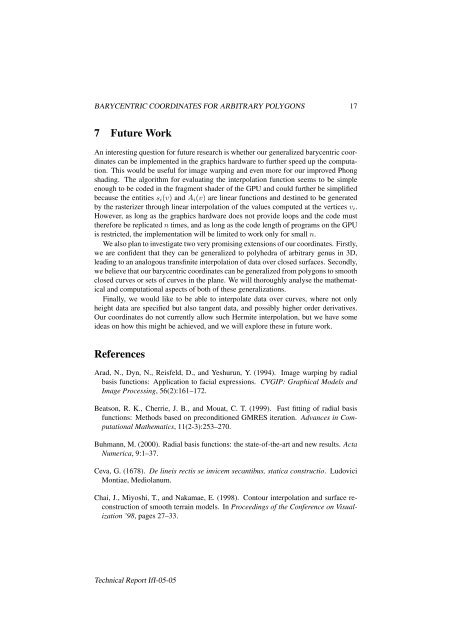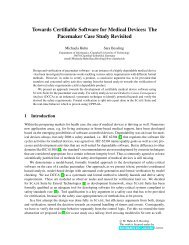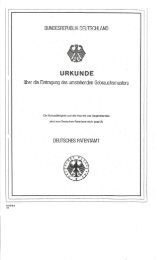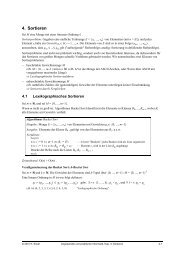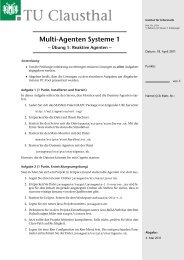Barycentric Coordinates for Arbitrary Polygons in the Plane
Barycentric Coordinates for Arbitrary Polygons in the Plane
Barycentric Coordinates for Arbitrary Polygons in the Plane
You also want an ePaper? Increase the reach of your titles
YUMPU automatically turns print PDFs into web optimized ePapers that Google loves.
BARYCENTRIC COORDINATES FOR ARBITRARY POLYGONS 17<br />
7 Future Work<br />
An <strong>in</strong>terest<strong>in</strong>g question <strong>for</strong> future research is whe<strong>the</strong>r our generalized barycentric coord<strong>in</strong>ates<br />
can be implemented <strong>in</strong> <strong>the</strong> graphics hardware to fur<strong>the</strong>r speed up <strong>the</strong> computation.<br />
This would be useful <strong>for</strong> image warp<strong>in</strong>g and even more <strong>for</strong> our improved Phong<br />
shad<strong>in</strong>g. The algorithm <strong>for</strong> evaluat<strong>in</strong>g <strong>the</strong> <strong>in</strong>terpolation function seems to be simple<br />
enough to be coded <strong>in</strong> <strong>the</strong> fragment shader of <strong>the</strong> GPU and could fur<strong>the</strong>r be simplified<br />
because <strong>the</strong> entities s i (v) and A i (v) are l<strong>in</strong>ear functions and dest<strong>in</strong>ed to be generated<br />
by <strong>the</strong> rasterizer through l<strong>in</strong>ear <strong>in</strong>terpolation of <strong>the</strong> values computed at <strong>the</strong> vertices v i .<br />
However, as long as <strong>the</strong> graphics hardware does not provide loops and <strong>the</strong> code must<br />
<strong>the</strong>re<strong>for</strong>e be replicated n times, and as long as <strong>the</strong> code length of programs on <strong>the</strong> GPU<br />
is restricted, <strong>the</strong> implementation will be limited to work only <strong>for</strong> small n.<br />
We also plan to <strong>in</strong>vestigate two very promis<strong>in</strong>g extensions of our coord<strong>in</strong>ates. Firstly,<br />
we are confident that <strong>the</strong>y can be generalized to polyhedra of arbitrary genus <strong>in</strong> 3D,<br />
lead<strong>in</strong>g to an analogous transf<strong>in</strong>ite <strong>in</strong>terpolation of data over closed surfaces. Secondly,<br />
we believe that our barycentric coord<strong>in</strong>ates can be generalized from polygons to smooth<br />
closed curves or sets of curves <strong>in</strong> <strong>the</strong> plane. We will thoroughly analyse <strong>the</strong> ma<strong>the</strong>matical<br />
and computational aspects of both of <strong>the</strong>se generalizations.<br />
F<strong>in</strong>ally, we would like to be able to <strong>in</strong>terpolate data over curves, where not only<br />
height data are specified but also tangent data, and possibly higher order derivatives.<br />
Our coord<strong>in</strong>ates do not currently allow such Hermite <strong>in</strong>terpolation, but we have some<br />
ideas on how this might be achieved, and we will explore <strong>the</strong>se <strong>in</strong> future work.<br />
References<br />
Arad, N., Dyn, N., Reisfeld, D., and Yeshurun, Y. (1994). Image warp<strong>in</strong>g by radial<br />
basis functions: Application to facial expressions. CVGIP: Graphical Models and<br />
Image Process<strong>in</strong>g, 56(2):161–172.<br />
Beatson, R. K., Cherrie, J. B., and Mouat, C. T. (1999). Fast fitt<strong>in</strong>g of radial basis<br />
functions: Methods based on preconditioned GMRES iteration. Advances <strong>in</strong> Computational<br />
Ma<strong>the</strong>matics, 11(2-3):253–270.<br />
Buhmann, M. (2000). Radial basis functions: <strong>the</strong> state-of-<strong>the</strong>-art and new results. Acta<br />
Numerica, 9:1–37.<br />
Ceva, G. (1678). De l<strong>in</strong>eis rectis se <strong>in</strong>vicem secantibus, statica constructio. Ludovici<br />
Montiae, Mediolanum.<br />
Chai, J., Miyoshi, T., and Nakamae, E. (1998). Contour <strong>in</strong>terpolation and surface reconstruction<br />
of smooth terra<strong>in</strong> models. In Proceed<strong>in</strong>gs of <strong>the</strong> Conference on Visualization<br />
’98, pages 27–33.<br />
Technical Report IfI-05-05


